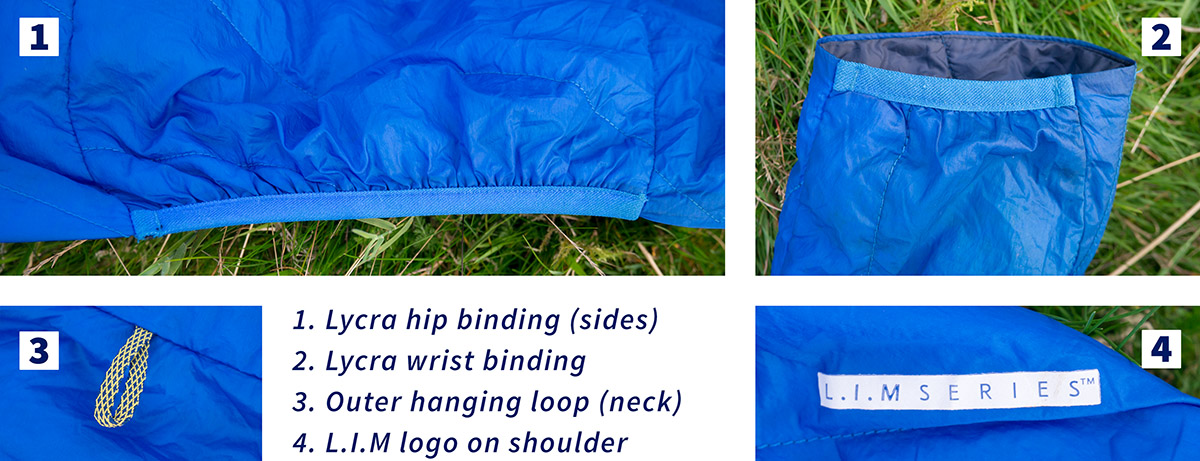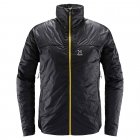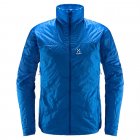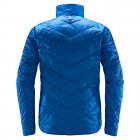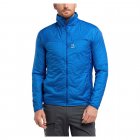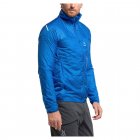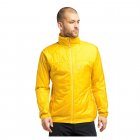Haglofs L.I.M Barrier Jacket (Primaloft Aerogel Version)
This product has been discontinued by Haglofs. Please see our review of OMM's Rotor Smock, which is slightly superior to the LIM Barrier and our current recommendation in our Lightweight Insulated Jacket category.
Special Mentions
Over time we've come across a number items that have really impressed us and we'd like to draw attention to, but ...
- either they don't quite fit into our rather strictly defined / narrow categories, or
- due to their high price-point, they cannot compete with our existing recommendations (mainly on the value score), or
- they will become our top choice, but only if and when our existing recommendation becomes unavailable (i.e. this item is the current heir in waiting but is just marginally edged out by our current recommendation).
So for such items we've created "special mentions" (SM). These "reviews" don't get a rating score and may receive less in-depth coverage and don't feature in our catalogue, instead the SM write-ups fall somewhere between a post and a formal review. They are identified by a blue Scramble mountain logo.
Intros out of the way, we'll proceed with our look at the Haglofs L.I.M Barrier Jacket (Primaloft Aerogel Cross Core version), and as always, we're looking at the item from the point of view of long distance trekking over tough terrain.
Test subject: Chest 42", Waist 33", Height: 5ft 8"
Test item: Size = Large
Kit Tests: Summer / Winter
Disclaimer: None required (item not provided by manufacturer)
Datasheet
| Materials (Face Fabric): 31 g/sm 15D Semi-Transparent Taffeta Polyamide | 100% |
| Insulation: Primaloft Gold with Cross Core (incorporating Primaloft Aerogel) | 40 g/sm |
| Treatments: Fluorocarbon free DWR | - |
| Weight (Size Large Stated / Measured) | 235 g / 232 g |
| Product Sizing Reference: 42" Chest = | L |
| Manufacturer RRP | £180.00 |
Scramble Review
Contents
- Introduction
- Haglofs On A LIM
- The Barrier's Cut
- Features
- Gridded Fleece Tangent
- Packability
- A Quick Note on the Gilet Version
- Any Negatives?
- Conclusion & Product Images
Introduction: Solid As Hot Air
Anyone who's read our piece on synthetic insulation will know that generally we've been unimpressed with the outdoor industry's disclosures of synthetic insulation (in terms of comparative thermal specifications), as though it's their dirty little secret; like down's disfigured brother, needy of protection from rigorous scrutiny and measure.
At Scramble, as most of our official testing takes place on the wettest parts of a wet isle, we're big fans of synthetic insulation and treat down as something of a softy that requires the protection of its more hardy, petroleum-based sibling.
There's a lot of unwarranted, over-promising hype in the outdoor industry, but every once in a while there's a new technology (or a new use for an old technology) that makes a substantive difference and is worthy of praise. One such leap is Primaloft's integration of a strange substance called Aerogel which has been embedded into their proprietary, polyester-based synthetic Gold insulation. Primaloft call this synthesis "Cross Core".
So, What Is Aerogel?
We'll let NASA explain:
Aerogel is a porous material in which the liquid component of a gel has been carefully dried out and replaced by gas, leaving a solid made up almost entirely of air. It long held the record as the world’s lightest solid and is also one of the most effective insulators in existence. While its inventor published his discovery in 1931, aerogel remained impractical for many decades due to its fragility and brittleness. NASA turned to the material to keep rocket fuel at cryogenic temperatures and worked with industry to create the world’s first practical, flexible aerogel blankets in the 1990s. Since then, aerogels have become widely used as insulation in subsea systems, oil refineries, industrial buildings, homes, refrigerators, jackets and shoe inserts.
For those who want to dig deeper into the strange properties of aerogels, the science channel Veritasium made two excellent mini-docs on the topic: "World's Lightest Solid" and a follow-up called "I Waterproofed Myself With Aerogel", both are interesting and well worth a watch.
Aerogel means synthetic insulation just got a lot lighter
What's important for our purposes is that Aerogel is like solid air. Trapped air is a great insulator and since Aerogel in Primaloft's Cross Core is more than 95% air, you're getting a large insulation boost with a very low weight premium.
The pitch from Primaloft (which so far in our testing seems about right) is that to convert the grams per square meter from Primaloft Gold Cross Core (Aerogel infused) into the traditional Primaloft Gold for an equivalent warmth comparison you need to add 50% (i.e. multiply by 1.5). So, a 40g/sm Primaloft Cross Core jacket should be equivalent to a 60g/sm Primaloft Gold jacket (such as Mountain Equipment's 2014 Compressor).
Perhaps a better comparison would be with Bergan's old hoodless Uranostind jacket, which had 60g/sm of Primaloft Gold insulation throughout and weighed 365g (size large). The Haglofs Aerogel LIM Barrier (L) weighs just 235g. If we multiply 235g by 1.5, we get 353g, which tells us that most of the weight savings are coming from the Aerogel insulation (we can guess that just around 12g are coming from fabric, zip and other design choices). Ultimately, Primaloft Gold Cross Core allows manufacturers to make top end synthetic jackets about two thirds of the weight of those we were getting just five or so years ago.
Haglofs on a LIM
Haglofs' L.I.M (Less Is More) range is pretty self explanatory. It's their stripped-down ultralight range for those gram counters among us who are always trying to travel as light as possible. As such, aside from their choice of insulation and outer fabric, what we have is pretty basic. Nothing wrong with that in our opinion, especially from something whose sole purpose is simply to keep you warm.
 The Haglofs Barrier features a boxy cut with a dropped back.
The Haglofs Barrier features a boxy cut with a dropped back.
The Barrier's Cut
The cut of the Haglofs Barrier is somewhat on the boxy side; it's not an "athletic" or tapered cut. When sizing for a jacket like this, I always make sure I can fit a lightweight down gilet or pull-on (like Crux's Halo or more current Turbo or Montane's Starlight) underneath. For me this meant choosing a size large and as you can see pictured above the Barrier is a little long in the body for a short-arse like me. However, I'm rarely bothered by too much coverage; too little is another matter.
When you first get hold of the lightest of the aerogel infused jackets, they almost feel bereft of any insulation at all and you wonder how these things are going to keep you warm. Yet they do - the "tech" actually works! I remember the first time I wore the Barrier jacket I had a strange feeling, as though I was somehow cheating and getting away with it.
Features: Less Is More?
More or less, yes. Less is more. This shouldn't take long.
The Barrier has a lightweight wind-blocking 15D polyamide shell fabric which is treated with a fluorocarbon free DWR.
The hoodless Barrier features a high collar which helps seal in the warmth and feels snug. It has two hand-warmer pockets with very tidy zips embedded into the seams (more on this below) and lycra binding in all the places you'd expect.
I admire Haglofs for sticking to their guns. It must have been tempting to feature the obligatory zipped chest pocket or an internal pocket for everybody's smartphone. But no. Warm hands, warm bodies and nothing more (or less).
 The Haglofs L.I.M Barrier has only what you need and nothing more.
The Haglofs L.I.M Barrier has only what you need and nothing more.
Let's zoom in and see if we can find anything less to talk about.
"Invisible" Zipped Hand Pockets
Embedded along the side seams of the jacket are two zips, given away only by the zip-pulls that project out from the seam. These don't seem to serve a particular practical purpose, but they make the jacket look even more minimalist than it already is. They are, like the main zip, reverse coil zips which prevents snagging when opening as the zip teeth point inward and thus avoid the surrounding fabric.
Below we've highlighted where we've zoomed in (pictured right, where we've marked the full length of the zip).
 The disappearing zip helps stress the minimalist look.
The disappearing zip helps stress the minimalist look.
Main Zip
The main zip is a YKK reverse coil whose full length is backed by a wind baffle. At the neck is a zip housing (or "garage"). The zip doesn't snag and works very smoothly. What does exist on the Barrier jacket is finished to a high standard and the zips are no exception.
 The zip baffle helps keep the warm air from escaping.
The zip baffle helps keep the warm air from escaping.
Inside
The inner seams are bound which helps to prevent warm air escaping. The lining is silky smooth and made from a similar weight taffeta nylon.
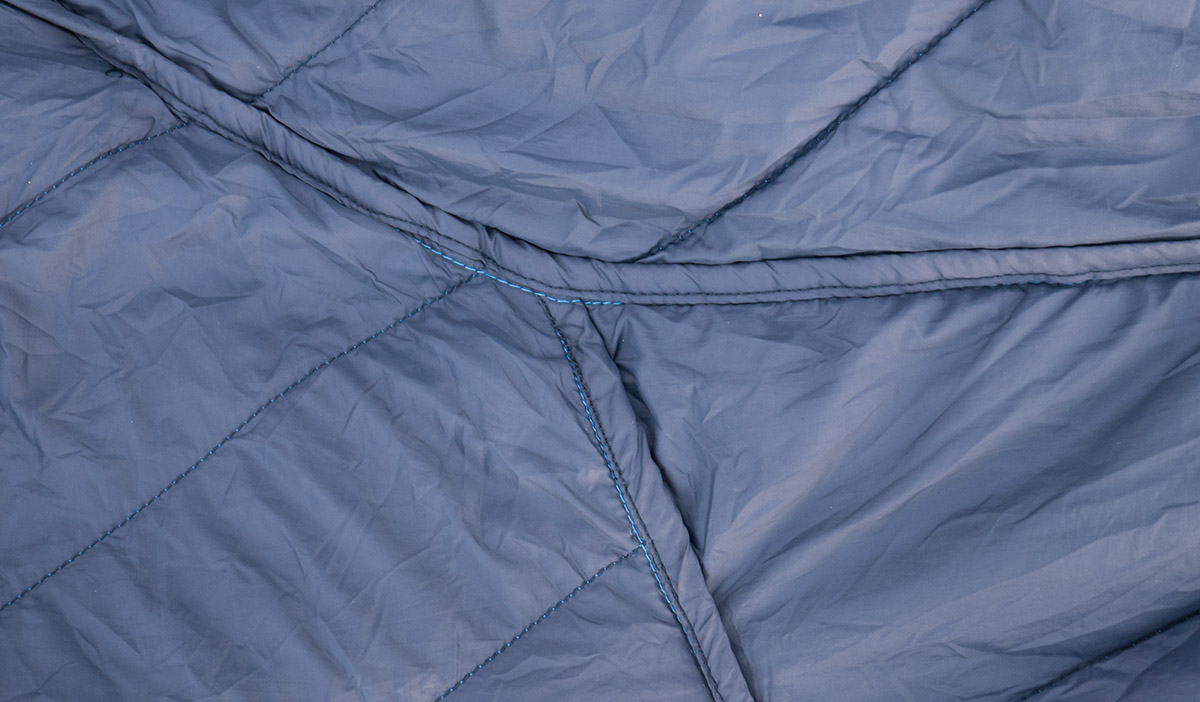 Nicely bound seems to help seal in the warmth.
Nicely bound seems to help seal in the warmth.
Lycra Binding, Loops and Logos
All that's left to add is the twin lycra bound sections at the hips (pic #1) which provide a moderate cinching (but not what you'd get from shockcord cinches). Likewise at the wrist (pic #2) and these work well and keep sleeves from falling over the hand.
At the back we've got a hanging loop (pic #3) and on the shoulder a reflective L.I.M logo.
And that's all there is to the L.I.M Barrier Jacket from Haglofs.
Gridded Fleece Tangent
We'll take a quick detour and talk about a fleece. The item below is a Rab Nexus Pull-On in Dark Sulphur. I'd had the hooded version for a few years (for personal use) and had been impressed by how warm it was and so was interested to test the lighter pull-on and squeezed it into the 2021 kit test line up.
We don't really recommend fleeces; they're bulkier, heavier and generally too warm for active use and not warm or windproof enough for static use. That said, we're not anti fleeces either and the Rab Nexus (both in hooded jacket and pull-on form) is an excellent item. It's impressively warm for its weight, it's very well designed and machined and it's sensibly priced. From what I've read from reviews, it's highly regarded by many in the outdoor community.
The 2021 Summer Kit Test (from Merthyr to Cnicht) was, for August, very cold and damp even for Wales (afternoon peak temperatures for at least 10 of the days failed to reach 20℃, with cold winds and rain). So I was actually grateful for this piece which I slept in on a couple of cold nights.
 Rab's Nexus Pull-On is a good quality, lightweight yet warm and packable gridded fleece.
Rab's Nexus Pull-On is a good quality, lightweight yet warm and packable gridded fleece.
So, if you're in the market for a fleece (whether for casual winter wear or for outdoor use) I can certainly recommend the Rab Nexus.
Apart from gratuitously plugging a nice bit of gear the real reason for this detour is to highlight another reason why we like the LIM barrier jacket so much.
Packability
Below is the LIM Barrier jacket packed away (left) and pictured on the right is the Rab Nexus (which for a fleece is quite packable). The picture doesn't quite get it across, but the Barrier jacket takes up less than half of the pack space of the Nexus fleece.
 Packability test: Haglofs L.I.M Barrier vs The Rab Nexus Pull-On
Packability test: Haglofs L.I.M Barrier vs The Rab Nexus Pull-On
So, not only is the Haglofs Barrier jacket much warmer, more windproof and water-resistant, its lighter (232g versus 264g, both measured, size large) and substantially more packable.
This is generally why we don't advocate fleeces. When you're active you're generating sufficient heat to not require a fleece, and if you're getting too cold it will be convection via the wind that's causing the heat loss (so additional wind protection is what's required not insulation per se). So, when active a good baselayer to keep you dry and a softshell to block most of the wind is our recommendation. When you're static (which is when you really do cool down), a good lightweight insulated jacket will always out-perform a fleece.
Haglofs L.I.M Barrier Vest (Primaloft Aerogel Version)
In conjunction with the Barrier jacket, Haglofs also released a lighter gilet version (my size Large weighs in at just 144g). In our view this is very much a luxury item and something that may be of interest if going cheap in the sales.
We contacted Haglofs to see if they were going to continue the Barrier Aerogel line, but have had no definitive answer. We hope they do, as Aerogel fits very well with Haglofs' "less is more" philosophy.
As we can see there's not a lot going on with the gilet version. Obviously, we lose the sleeves, we also lose the two hand pockets and get in return a single zipped chest pocket. This makes sense since Haglofs clearly assume this will mainly be worn under other layers.
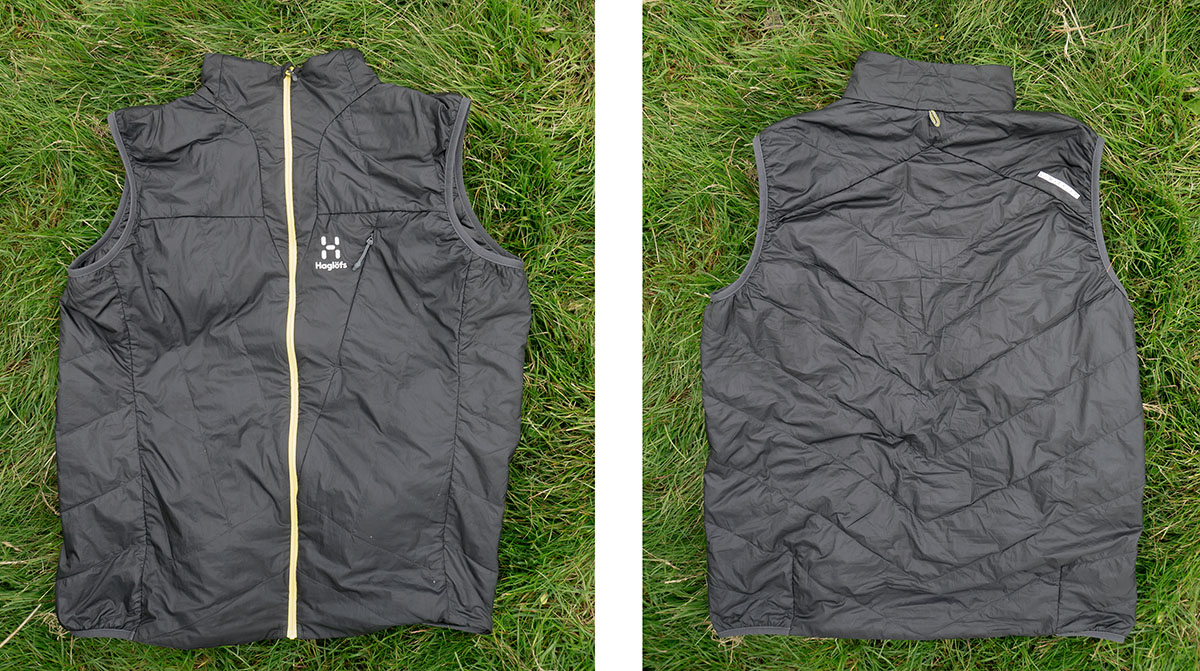 Haglofs L.I.M Barrier Vest (Gilet) has even less going on than the jacket.
Haglofs L.I.M Barrier Vest (Gilet) has even less going on than the jacket.
The LIM Barrier Vest is one of those items that's very tempting to throw into your pack "just in case". In summer, it certainly would replace a fleece, providing more wind resistance for the body's core and more warmth than a light polartec or gridded fleece. In winter, if you think conditions may leave you a little light in the insulation department, this little gilet may add just enough supplemental warmth to get you through.
I've now taken this on both summer and winter kit tests and it's certainly been nice to have around. Does it justify its full (~£140 RRP) price tag? No, we'd say it doesn't. However, if you ever see it at 50% off or more, and have some spare cash lying around, then it's certainly worth considering.
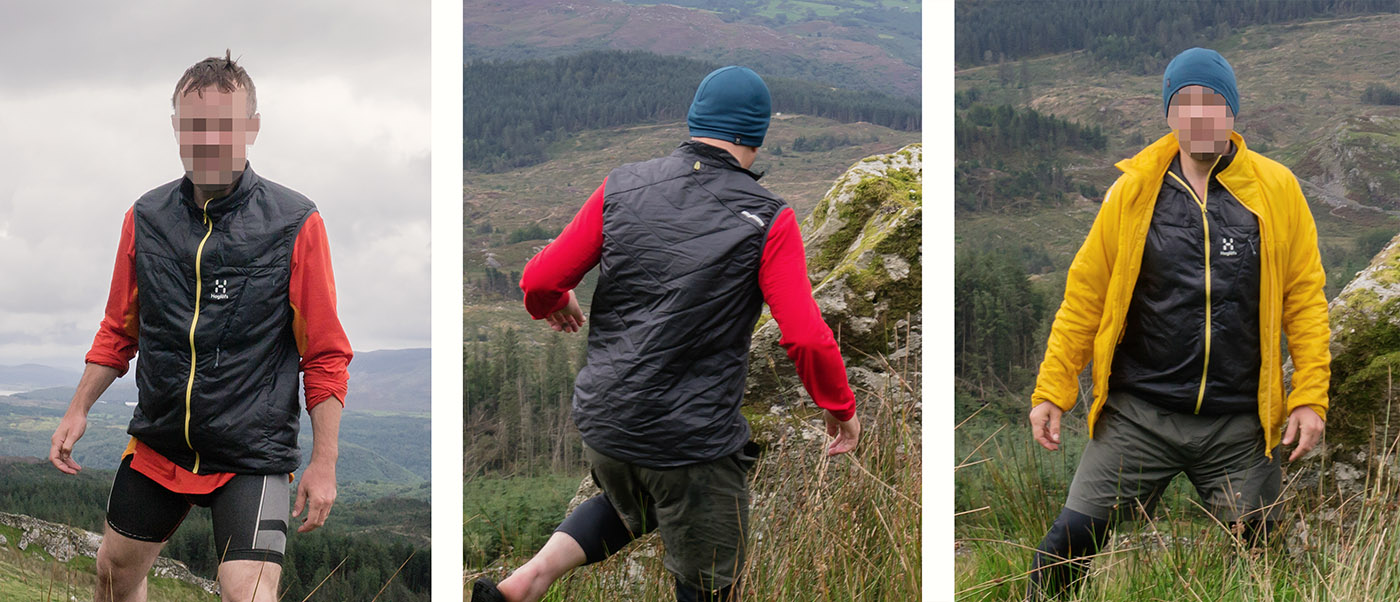 Models aren't paid enough. Missing my mark (pic #2) so you got a back view.
Models aren't paid enough. Missing my mark (pic #2) so you got a back view.
Not a great deal to discuss that hasn't been mentioned in the jacket review. The lycra binding carries across to the gilet and appears at the hip (pic #3 below) and shoulders (pic #2). The chest pocket zip has the same discrete finishing (and is pictured fully open in picture #1 below).
 Zips and binding are carried over from the Barrier jacket.
Zips and binding are carried over from the Barrier jacket.
Let's get back to the pricey, but ultimately better value, Barrier Jacket and see if there's any negatives to gripe about.
Any Negatives?
Time to nitpick.
Personally, I'd prefer a slightly less boxy cut - a little less around the midriff / waist and a little extra around the shoulder and chest. A slightly more athletic cut would be ideal. But body shape / composition is a very personal matter and if I was 6' 2", had the chest of a trail-runner, a size medium might be a perfect match.
We'd also prefer a little more aggressive elastication at the hip.
Both of these niggles are really minor and I was so impressed with the Haglofs Barrier that I bought an additional one for personal use. We also picked up the Barrier gilet (144g for future Scramble Kit Tests).
Also, worth noting is that we'll be testing Rab's Generator Alpine Jacket (another Primaloft Aerogel insulation piece), hopefully this winter.
Conclusion
Primaloft's integration of Aerogel into their premium synthetic insulation has finally bridged the gap between synthetic and down. When you look at some of the premium down pull-ons like the Crux Turbo (£230) for example which uses 75g of 900 fill power goose down, the weight difference minimally favours the Haglofs' synthetic (Large Barrier = 235g, Medium Turbo = 235g).
It's hard to know which is warmer, but my guess is that they're roughly on a par. What we do know is that for wet conditions one used to pay a significant weight premium for synthetic and those days are now behind us, at least for jackets that use Primaloft's Cross Core insulation.
We've long felt that 60g/sm of premium synthetic is where meaningful insulation begins for the static user. We wouldn't want to go any lighter than the Barrier jacket (at 40g/sm of this Aerogel infused insulation). But at just 235g for a size large, the Barrier is genuinely ultralight.
We're hoping to test the Barrier in conjunction with a quality down pull-on to see how this combination will perform in sub-zero conditions. But at present the L.I.M Barrier jacket from Haglofs is a fantastic ultralight option for cold summer nights and the adjacent seasons.
Everything on the Barrier is finished to Haglofs high standards and though, with a full RRP of £180, it's not cheap by any means, it's still competitive against jackets pushing "traditional insulation" to its lightweight limits, such as:
- Patagonia's £180 Nano Puff ( 60g/sm PrimaLoft Gold Insulation Eco, at 340g), or
- Rab's £170 Xenon X ( 60g/sm PrimaLoft Gold Insulation Eco, at 345g)
... and in our opinion the Barrier should also be measured against some of the pricey high-end down pieces too.
We need to do some more testing, but if Haglofs continue to produce the Barrier jacket we can see this becoming our recommendation in the Lightweight (<400g) Insulated Jacket category.
An outstanding, high quality, minimalist and genuinely ultralight insulated jacket with some old fashioned NASA tech thrown in, the Haglofs L.I.M Barrier Jacket with Cross Core Aerogel is definitely worthy of a special mention and in our view is the future of synthetic insulation. We'll put our money on a little "solid air" over "blown into baffles to mimic down".
Product Images
Last Updated: 24/11/23


